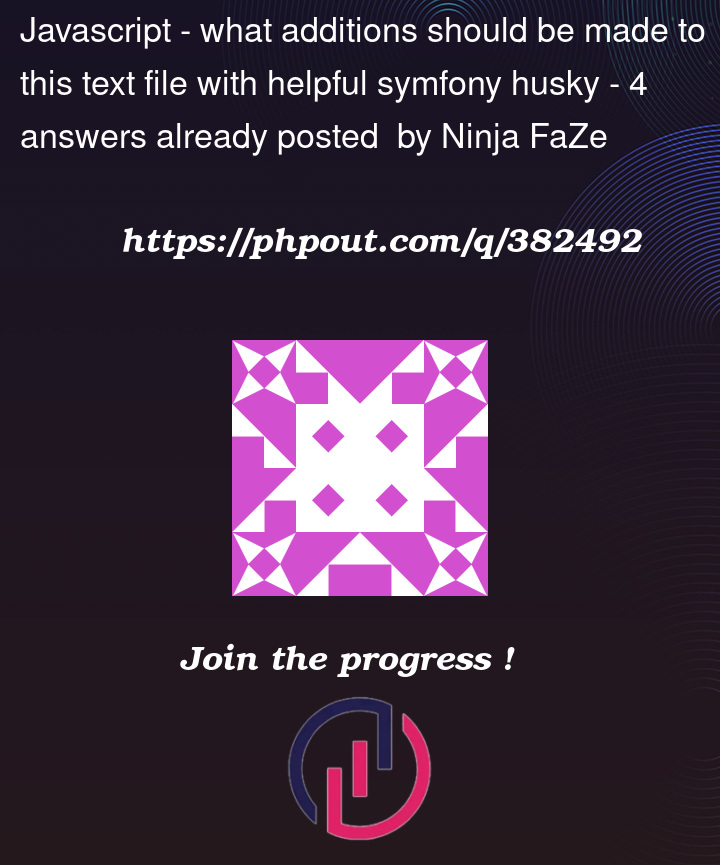Symfony Installation:
Created a Symfony project using Composer with the symfony/skeleton package.
Added the webapp package using Composer.
composer create-project symfony/skeleton:"7.0.*" symfony_test_app
composer require webapp
Database Setup:
Configured the database URL with credentials.
Created the database schema using Symfony's Doctrine commands.
DATABASE_URL="mysql://username:password@host:port/database_name?serverVersion=10.4.28-MariaDB&charset=utf8mb4"
php ./bin/console doctrine:database:create
php bin/console doctrine:schema:update –force
Symfony Packages Installation:
Installed essential Symfony packages like symfony/orm-pack, symfony/form, symfony/maker-bundle, and symfony/framework-bundle.
Generated migrations, entities, forms, user authentication, etc., using Symfony's console commands.
composer require symfony/orm-pack
composer require symfony/form
composer require symfony/maker-bundle --dev
composer require symfony/framework-bundle
php bin/console make:migration
php bin/console make:entity
php bin/console make:form PersonType Person
php bin/console make:user
php bin/console make:auth
Front-end Dependencies:
Included Bootstrap and jQuery CDN links for styling and client-side scripting.
<link href="https://cdn.jsdelivr.net/npm/[email protected]/dist/css/bootstrap.min.css" rel="stylesheet" integrity="sha384-QWTKZyjpPEjISv5WaRU9OFeRpok6YctnYmDr5pNlyT2bRjXh0JMhjY6hW+ALEwIH" crossorigin="anonymous">
<script src="https://code.jquery.com/jquery-3.6.0.min.js"></script>
<script src="https://stackpath.bootstrapcdn.com/bootstrap/4.3.1/js/bootstrap.min.js"></script>
Front-end Script:
Added JavaScript code to filter items based on categories using Bootstrap's button groups.
<script>
$(document).ready(function(){
$(".filter-button").click(function(){
var value = $(this).attr('data-filter');
if(value === "all") {
$('.filter').show('1000');
} else {
$(".filter").not('.'+value).hide('slow');
$('.filter').filter('.'+value).show('slow');
}
$(".filter-button").removeClass("active");
$(this).addClass("active");
});
});
</script>
Symfony Controller:
Created a Symfony controller named RegistrierungController for handling user registration.
Defined a route /registrierung for accessing the registration form.
<?php
namespace AppController;
use AppEntityUser;
use DoctrineORMEntityManagerInterface;
use SymfonyComponentFormExtensionCoreTypePasswordType;
use SymfonyComponentFormExtensionCoreTypeRepeatedType;
use SymfonyComponentFormExtensionCoreTypeSubmitType;
use SymfonyComponentFormExtensionCoreTypeTextType;
use SymfonyComponentHttpFoundationRequest;
use SymfonyBundleFrameworkBundleControllerAbstractController;
use SymfonyComponentHttpFoundationResponse;
use SymfonyComponentPasswordHasherHasherUserPasswordHasherInterface;
use SymfonyComponentRoutingAnnotationRoute;
class RegistrierungController extends AbstractController
{
#[Route('/registrierung', name: 'app_registrierung')]
public function reg(Request $request, EntityManagerInterface $entityManager, UserPasswordHasherInterface $passwordHasher): Response
{
// Form handling logic here...
}
}
Twig Template:
Utilized Twig templating engine to render the registration form.
Extended the base template to maintain consistency across pages.
Rendered the registration form using Symfony's form rendering functions.
twig
{% extends 'base.html.twig' %}
{% block title %}Hello RegistrierungController!{% endblock %}
{% block body %}
<h1>RegistrierungController</h1>
{{ form_start(regform) }}
{{ form_widget(regform) }}
{{ form_end(regform) }}
{% endblock %}
Front-end Component:
Implemented a carousel component using Bootstrap's Carousel to display car details.
Dynamically populated car details using Twig's loop syntax.
Linked each carousel item to a detailed view page using Symfony's routing system.
<section>
<div id="carouselExampleSlidesOnly" class="carousel slide" data-ride="carousel" data-interval="3000">
<div class="carousel-inner">
{% for car in cars %}
<div class="carousel-item {% if loop.first %}active{% endif %}">
<h2>{{ car.getModel() }}</h2>
<img class="carousel-image" src="{{ asset('images/' ~ car.getImage()) }}" alt="{{ car.getBrand() }}">
<br>
<a class="details-button" href="{{ path('car_details', {'id': car.getId()}) }}">Click here for more details</a>
</div>
{% endfor %}
</div>
</div>
</section>
This setup provides a comprehensive guide for setting up a Symfony application with user registration and front-end components like filtering buttons and carousels for displaying data.




4
Answers
Dropdown
Action
Another action
Something else here
How to make the pictures displayed:
Something more for the register controller:
In der index.html.twig
delete the stuff in the div and add the following:
Jetzt einen beliebigen User erstellen und sehen, ob er in der DB gespeichert wird
In CustemAuthenticator
In the Function: onAuthenticationSuccess
The Row with „throw“ comment out and in the following to paste:
security.yaml
In the file “config/packages/security.yaml” the folliwing to paste in:
At the subpoint „firewall“:
And at the extra subpoint
A Menu for public and one only for logged in User
#[Route(‘/car/new’, name: ‘car_new’, methods: [‘GET’, ‘POST’])]
public function new(Request $request, EntityManagerInterface $entityManager): Response
{
for picture